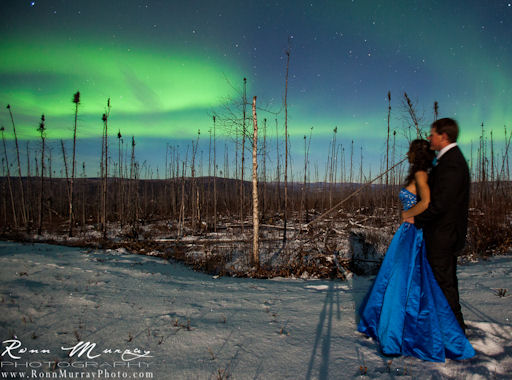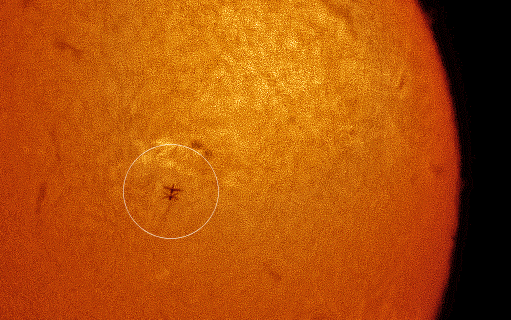SUBSIDING CHANCE OF FLARES: Sunspot AR1598 has decayed since it unleashed an X1-class solar flare on Oct. 23rd. The daily odds of a similar eruption from the active region have dropped to only 5%, according to NOAA forecasters. Solar flare alerts: text, voice.
BRIDE, GROOM, AURORAS: Space weather can have a big influence on human affairs--and we're not just talking about radio blackouts and power outages. Last night, photographers Ronn Murray and Marketa Stanczykova were married under the Northern Lights in Alaska, and according to the groom, it was space weather that brought them together:
"Marketa Stanczykova and I met after a she looked me up from Iceland when she found this image on the cover of spaceweather.com 1 year and 21 days ago," explains Ronn. "We became friends on Facebook and after shooting auroras together in Alaska we fell in love. So, we gathered a small group of friends and headed up to the University of Alaska's Poker Flat Research Range where the aurora is studied. Last night we said 'I do' in front of the AuroraCam for all the world to see." (continued below)
"This is a self portrait of the aurora and wedding photographers celebrating their own love under the magnificent lights."
"The sky was dark and aurora activity was non existent until we pulled up to the observatory," he adds. "As if by magic, the sky came alive and we were able to say our vows with a select group of incredible friends, the amazing aurora that brought us together, and the Aurora Cam as our witnesses. It was a day none of us will forget!"
SPLIT-SECOND TIMING: When the International Space Station (ISS) passes in front of the sun at 17,000 mph, the entire transit usually takes less than one second. Photographing the passage requires skill, experience, and split-second timing. Yesterday in San Diego, photographer Houston Haynes did it using pure luck:
"I randomly and unintentionaly recorded the ISS as it transited the solar disc on Oct. 25th," says Haynes. "What luck! Using my H-alpha telescope, I was video-recording the sun at 15 frames per second; the ISS appeared in roughly 9 frames."
Photographers who wish to photograph the station's silhouette on purpose should check Calsky for transit predictions, and monitor the gallery for results.

![]()
Solar wind
speed: 340.0 km/sec
density: 0.5 protons/cm3
explanation | more data
Updated: Today at 1425 UT
![]()
X-ray Solar Flares
6-hr max: C1 1104 UT Oct26
24-hr: C1 1104 UT Oct26
explanation | more data
Updated: Today at: 1400 UT
![]()
![]()
![]()
Daily Sun: 26 Oct 12
![]()
![]()
Decaying sunspot 1598 poses a slim threat for M-class solar flares. Credit: SDO/HMI
![]()
![]()
![]()
Sunspot number: 58
What is the sunspot number?
Updated 26 Oct 2012
Spotless Days
Current Stretch: 0 days
2012 total: 0 days (0%)
2011 total: 2 days (<1%)
2010 total: 51 days (14%)
2009 total: 260 days (71%)
Since 2004: 821 days
Typical Solar Min: 486 days
Update 26 Oct 2012
The Radio Sun
10.7 cm flux: 130 sfu
explanation | more data
Updated 26 Oct 2012
![]()
![]()
![]()
Current Auroral Oval:
![]()
Switch to: Europe, USA, New Zealand, Antarctica
Credit: NOAA/POES
![]()
![]()
![]()
Planetary K-index
Now: Kp= 1 quiet
24-hr max: Kp= 2 quiet
explanation | more data
![]()
Interplanetary Mag. Field
Btotal: 5.2 nT
Bz: 3.9 nT south
explanation | more data
Updated: Today at 1427 UT
![]()
![]()
![]()
Coronal Holes: 26 Oct 12
![]()
![]()
There are no large coronal holes on the Earthside of the sun. Credit: SDO/AIA






